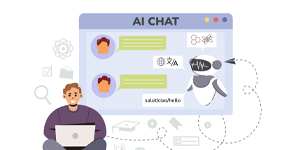How to Use Interview Chatbots Without Losing Personal Touch
In today’s fast-paced hiring landscape, companies are increasingly turning to interview chatbots and AI in recruitment to streamline the hiring process. From answering candidate queries instantly to conducting pre-screening interviews, recruitment chatbots have become one of the most valuable HR automation tools available. However, one major concern persists — how can organizations adopt these digital recruitment solutions without compromising the candidate experience or losing the “human touch” that defines great hiring?
The Rise of Interview Chatbots in Modern Recruitment
In recent years, AI in recruitment has transformed from a forward-thinking experiment into an essential component of the modern hiring process. As businesses race to attract top talent in competitive markets, speed, consistency, and candidate engagement have become critical. To meet these demands, interview chatbots have emerged as one of the most effective tools in the HR technology ecosystem.
These AI-powered systems are designed to streamline repetitive administrative tasks that once consumed a significant portion of recruiters’ time. Instead of spending hours manually screening resumes, sending follow-up emails, or coordinating interview schedules, recruiters can now rely on automation to handle these functions seamlessly. The result is a faster, smarter, and more scalable hiring process that enhances efficiency without sacrificing quality.
What Are Interview Chatbots?
Interview chatbots are intelligent, automated conversational agents capable of engaging with job applicants through text-based chat windows, messaging apps, or even voice interactions. These digital recruitment solutions can be programmed to ask pre-screening questions, collect candidate data, schedule interviews, and provide instant feedback — all in real time and without human supervision.
Available 24 hours a day, 7 days a week, interview chatbots ensure that no candidate is left waiting for a reply. Whether it’s a question about job requirements, application status, or interview logistics, these systems respond instantly, creating a smoother and more responsive candidate experience.
Beyond basic communication, many advanced recruitment chatbots leverage natural language processing (NLP) and machine learning to interpret candidate responses and assess key qualifications. They can analyze tone, detect relevant skills, and even rank applicants based on job fit. This intelligent automation helps recruiters make data-driven decisions while maintaining consistency across every stage of the hiring journey.
The Role of Recruitment Chatbots in Modern Hiring
In today’s digital-first recruitment landscape, recruitment chatbots often serve as the first point of contact between a company and a potential hire. Acting as virtual assistants, they gather preliminary information such as educational background, work experience, and role-specific skills. They can also handle FAQs, guide candidates through the application process, and update applicants on next steps.
By managing these early interactions, interview chatbots allow human recruiters to focus on more strategic and value-driven tasks — such as assessing cultural fit, building relationships, and making final hiring decisions. This division of labor between AI and people not only boosts productivity but also improves the overall candidate experience by ensuring every applicant receives timely communication and personalized engagement.
Moreover, the implementation of AI in recruitment is helping organizations achieve new levels of scalability. Whether a company receives 100 applications or 10,000, a well-designed chatbot can manage the influx efficiently without overwhelming HR teams. As a result, businesses can expand their hiring capacity while maintaining a high level of professionalism and responsiveness.
The Benefits of Interview Chatbots in Recruitment
When implemented strategically, interview chatbots bring substantial value to recruitment teams and candidates alike. Below are key advantages companies experience when using AI in recruitment.
Efficiency and Time Savings
One of the most recognized benefits of HR automation tools is efficiency. Recruitment chatbots can handle thousands of candidates simultaneously, screening resumes, collecting basic information, and setting up interviews within minutes. This automation drastically reduces the time-to-hire and minimizes administrative workload for HR teams.
24/7 Availability
Candidates no longer need to wait for business hours to receive responses. With interview chatbots, applicants can interact at any time, from any location. This always-on capability improves responsiveness and enhances the candidate experience — one of the key goals of digital recruitment solutions.
Consistency and Fairness
Unlike human recruiters who may unintentionally display bias or fatigue, interview chatbots treat every applicant equally. They ask standardized questions, evaluate based on pre-set criteria, and ensure that every candidate receives the same opportunities for assessment.
Enhanced Candidate Engagement
Through personalized messages, instant feedback, and interactive dialogue, recruitment chatbots keep candidates engaged throughout the process. Many organizations report higher satisfaction scores and improved candidate experience metrics after integrating chatbots into their recruitment pipelines.
Integration with HR Systems
Modern HR automation tools can seamlessly integrate with applicant tracking systems (ATS), video interviewing platforms, and onboarding solutions. This allows AI in recruitment to work holistically — optimizing workflows from job posting to offer acceptance.
The Challenges of Interview Chatbots
Despite their advantages, the implementation of interview chatbots comes with its share of challenges. Understanding these potential pitfalls is critical to ensuring successful adoption without diminishing the human aspect of recruitment.
Lack of Personal Touch
Perhaps the most significant drawback of recruitment chatbots is the perceived loss of human connection. Candidates want to feel that they’re interacting with people who understand their ambitions, emotions, and personality — not just a machine.
Misinterpretation of Responses
While AI in recruitment has advanced significantly, chatbots can still struggle with nuances such as sarcasm, cultural context, or ambiguous answers. This may lead to inaccurate assessments or frustrating candidate experiences.
Over-Automation Risks
Relying too heavily on automation can alienate candidates who expect empathy and personal acknowledgment. When every interaction feels robotic, organizations risk damaging their employer brand and losing qualified talent.
Technical and Ethical Concerns
HR automation tools must comply with data privacy regulations such as GDPR. Mishandled data, biased algorithms, or lack of transparency can result in legal and ethical challenges for organizations.
How to Implement Interview Chatbots Without Losing Personal Touch
The real art lies in balancing automation with empathy. Here’s how companies can introduce interview chatbots effectively while preserving the human element that defines meaningful recruitment.
Design Chatbots with Empathy
The tone and personality of your recruitment chatbots play a vital role in shaping candidate experience. Instead of using stiff corporate language, design conversational flows that sound friendly, respectful, and approachable. Adding small touches — like greetings, encouraging phrases, or follow-up messages — can make interactions feel human.
Maintain Human Oversight
Even when using AI in recruitment, recruiters should monitor chatbot interactions regularly. Human oversight ensures that candidates receive personalized feedback and that unusual cases are handled with sensitivity. Chatbots should handle routine questions, but complex issues should still be escalated to human recruiters.
Offer Human Contact Options
Always provide an option for candidates to connect with a real person. For instance, if an applicant asks a question beyond the chatbot’s scope, the system should seamlessly hand over the conversation to a recruiter. This small step significantly improves trust and keeps the candidate experience authentic.
Personalize Automation
Use data intelligently. HR automation tools can personalize communication based on candidate profiles, such as mentioning specific skills or job preferences. When candidates feel the chatbot “knows” them, they perceive the process as more personal.
Balance Automation and Interaction Stages
Interview chatbots should be used strategically — ideally for pre-screening, FAQs, and scheduling. Once candidates advance to later stages, human recruiters should take over to provide deeper engagement. This hybrid model is one of the best practices for using AI chatbots in recruitment.
Chatbot Interview Tips for Recruiters
Introducing interview chatbots requires thoughtful planning. Below are practical chatbot interview tips to ensure successful implementation:
1. Start Small: Begin with one part of the recruitment process — such as pre-screening or scheduling — before scaling up.
2. Train the AI Continuously: The effectiveness of AI in recruitment depends on data quality. Feed your chatbot with real-world conversation data and continuously improve its responses.
3. Test the Candidate Experience: Before deployment, test the chatbot internally with different personas to evaluate tone, clarity, and empathy.
4. Gather Feedback: Encourage candidates to share feedback on their interaction with the chatbot. Use insights to enhance the candidate experience.
5. Monitor Performance Metrics: Track key indicators like response times, completion rates, and satisfaction scores to measure chatbot effectiveness.
When executed thoughtfully, these chatbot interview tips can help organizations maximize automation while maintaining human warmth in every interaction.
Examples of Successful Chatbot Use in Recruitment
To understand the real-world impact, let’s explore examples of successful chatbot use in recruitment across various industries.
Example 1: Unilever’s Recruitment Chatbot “Unabot”
Unilever introduced a recruitment chatbot that handles initial candidate interactions. It guides applicants through pre-screening, gamified assessments, and scheduling interviews. The result? The company reduced hiring time by 75% and improved candidate experience ratings globally.
Example 2: Marriott International’s “MC” Chatbot
Marriott’s interview chatbot, named MC, engages with job seekers via social media. It answers frequently asked questions, recommends suitable roles, and directs applicants to the careers portal. This digital recruitment solution has significantly increased candidate engagement and application rates.
Example 3: L’Oréal’s “Mya”
L’Oréal implemented AI in recruitment through their chatbot, “Mya.” It communicates with candidates across multiple languages, provides instant updates, and assists recruiters in shortlisting applicants. The brand reports enhanced satisfaction levels and greater efficiency in high-volume hiring.
These examples of successful chatbot use in recruitment highlight that automation doesn’t have to replace humanity — it can amplify it when executed with empathy and strategy.
Best Practices for Using AI Chatbots in Recruitment
Organizations adopting interview chatbots should adhere to key best practices for using AI chatbots in recruitment to ensure a positive and effective rollout.
Define Clear Objectives
Before implementing any HR automation tools, identify specific recruitment pain points. Are you looking to shorten time-to-hire, reduce screening workload, or improve candidate communication? Clearly defined objectives will guide your chatbot’s design and deployment.
Ensure Compliance and Transparency
Communicate clearly to candidates that they are interacting with a chatbot. Transparency builds trust and helps manage expectations. Also, ensure that your chatbot complies with data privacy standards to protect candidate information.
Regularly Update Content
Job roles and company policies evolve. Regularly review and update your chatbot’s responses to reflect accurate information. Outdated or inconsistent answers can quickly erode the candidate experience.
Humanize Your Brand Voice
Your chatbot’s tone should align with your company culture. Whether friendly and casual or formal and professional, maintaining brand consistency helps candidates connect emotionally with your organization.
Combine Data with Human Judgment
Even the most advanced AI in recruitment should complement, not replace, human insight. Recruiters must interpret data-driven recommendations and make final decisions based on intuition, empathy, and experience.
Following these best practices for using AI chatbots in recruitment ensures that organizations balance efficiency with empathy, keeping the process transparent, inclusive, and candidate-focused.
The Future of Interview Chatbots and Digital Recruitment Solutions
The future of interview chatbots looks promising. As natural language processing (NLP) and sentiment analysis technologies evolve, chatbots will become even more capable of understanding human emotions, tone, and intent. This advancement will bring us closer to creating fully personalized digital recruitment solutions that feel as human as they are intelligent.
AI in Recruitment Beyond Chatbots
Beyond interviews, AI in recruitment is transforming how companies attract and retain talent. Predictive analytics now forecast candidate success, AI-driven sourcing tools identify hidden talent, and automation ensures inclusive hiring practices. HR automation tools will continue to evolve, offering recruiters more data-driven insights while minimizing administrative burdens.
Human Touch Will Always Matter
Even as technology advances, the human element remains irreplaceable. Empathy, intuition, and real-world understanding are traits no machine can fully replicate. Thus, the best recruitment strategies of the future will combine interview chatbots for efficiency with human recruiters for connection and authenticity.
Balancing Technology and Humanity in Recruitment
Implementing interview chatbots doesn’t mean replacing recruiters — it means empowering them. Recruiters can use HR automation tools to handle repetitive tasks, freeing time for strategic functions such as cultural fit evaluation, leadership assessment, and relationship building.
A successful candidate experience comes from both speed and sincerity. Chatbots deliver the first, while humans ensure the second. Together, they create a recruitment ecosystem that’s efficient, empathetic, and future-ready.
When planning how to implement interview chatbots without losing personal touch, organizations should remember three guiding principles:
1. Automation should serve people, not replace them.
2. Empathy should remain at the heart of every interaction.
3. Technology should reflect company values and enhance relationships.
Conclusion
The integration of interview chatbots into modern hiring is no longer optional — it’s essential. However, success lies in using AI in recruitment thoughtfully. When recruitment chatbots are implemented with empathy, transparency, and strategy, they not only streamline processes but also elevate the candidate experience.
As organizations continue exploring digital recruitment solutions, the key question will remain: how to maintain authenticity in a world of automation? The answer lies in design, balance, and intent. By following best practices for using AI chatbots in recruitment, addressing the benefits and challenges of interview chatbots, and learning from examples of successful chatbot use in recruitment, HR leaders can build a future where technology and humanity work hand in hand.
In short, knowing how to implement interview chatbots without losing personal touch is not about choosing between humans and machines — it’s about making them stronger together.





